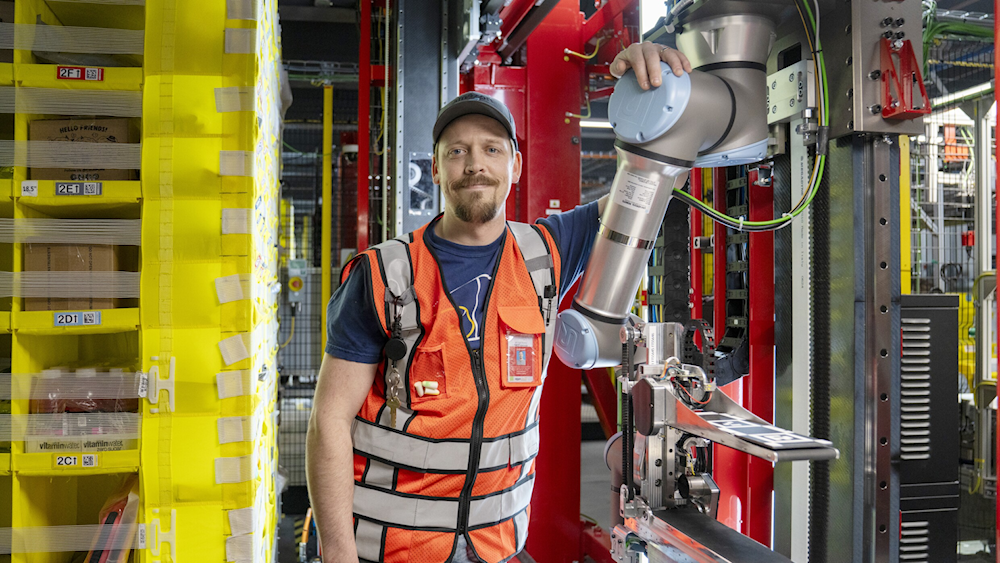Amazon makes ‘fundamental leap' in robotics with sense of touch device
Amazon recently revealed the Vulcan, a touch-sensitive robot set to revolutionize warehouse automation and logistics across global fulfillment centers.
-

An Amazon manufacturing worker stands next to the Vulcan robot at an Amazon work site. (Amazon website)
Amazon has unveiled its most advanced robot to date, Vulcan, marking what the company calls a “fundamental leap forward in robotics.”
Designed with a sense of touch, Vulcan is capable of handling nearly 75% of the vast range of items stored across Amazon’s fulfillment centers. The robot was launched at the company’s “Delivering the Future” event in Dortmund, Germany, and is expected to be deployed globally over the coming years.
Aaron Parness, Amazon’s director of robotics, said Vulcan represented a critical advancement, “It’s not just seeing the world, it’s feeling it, enabling capabilities that were impossible for Amazon robots until now.” Using AI, the Vulcan robot can determine how to pick up items based on texture and sensitivity, an ability that surpasses the suction-based systems currently used.
The new robot will help store and retrieve goods on multiple levels of storage pods, eliminating the need for human workers to climb ladders or bend repeatedly. Amazon, which now operates over 750,000 robots worldwide, sees Vulcan as the latest step in its warehouse automation strategy.
How AI is shaping the future of logistics
With AI guiding its actions, Vulcan can assess which objects are safe to handle and adjust its approach accordingly. It is designed to work alongside human employees who manage inventory from stations where shelving units are delivered by existing wheeled robots.
The robot is part of a broader Amazon initiative to integrate machine learning and automation into its logistics systems. For instance, the company plans to install packaging systems that tailor boxes to fit items precisely, cutting waste and improving efficiency. Over 70 of these machines will be deployed in the UK, Germany, France, Italy, and Spain by year-end, with additional units expected by 2027.
Impact on warehouse jobs and labor concerns
The introduction of Vulcan and similar robotics is likely to intensify concerns over job displacement. Amazon has already faced industrial action in the UK and beyond due to disputes over warehouse pay and working conditions, while broader anxieties about automation persist across the labor market.
In 2023, Goldman Sachs estimated that as many as 300 million jobs could be automated out of existence globally by 2030 due to advancements in AI. The Tony Blair Institute projected that, in the UK alone, between 60,000 and 275,000 jobs could be displaced annually during peak disruption.
Safety, efficiency, and the role of human workers
Despite concerns, Amazon maintains that human labor will remain central to its operations. Tye Brady, the company’s chief technologist for robotics, emphasized that robots are meant to “amplify the human potential” and take on “the menial, the mundane and the repetitive” tasks.
“People will always be part of the equation,” he said.
Brady, who described the Vulcan robot as similar to R2D2 in function, added that humans are still essential to applying common sense and identifying both system failures and simple issues, such as broken items, that robots might overlook.
Brady also argued that having people involved improves cybersecurity readiness, citing the recent shutdown of Marks & Spencer’s online orders due to a cyber-attack as an example of the growing need for vigilance.
Amazon’s continued investment in robotics aligns with a broader trend among global retailers responding to rising labor costs by automating logistics operations. The launch of the Vulcan robot, alongside packaging innovations and the rollout of Amazon’s new Haul website in the UK, signals a decisive move toward enhanced operational efficiency.
As Brady put it, “It’s really exciting to bring both the mind and the body together. It’s finally here, and it’s just beginning.”

 4 Min Read
4 Min Read








